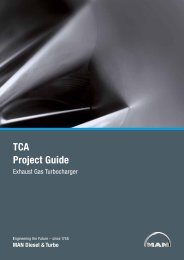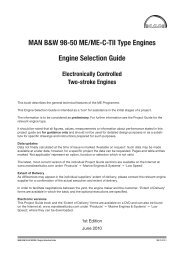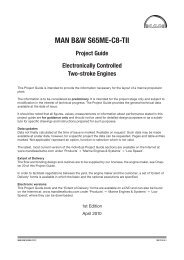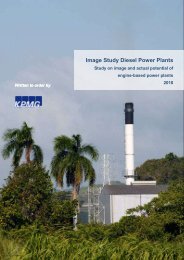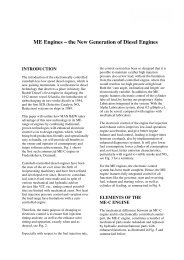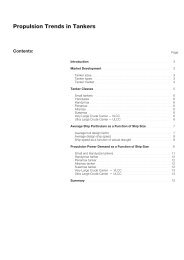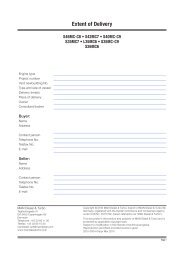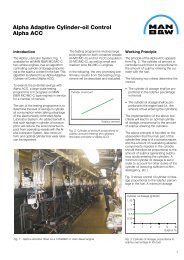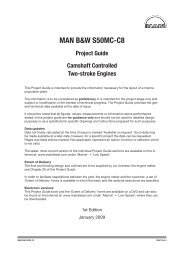This section is available on request - MAN Diesel & Turbo
This section is available on request - MAN Diesel & Turbo
This section is available on request - MAN Diesel & Turbo
You also want an ePaper? Increase the reach of your titles
YUMPU automatically turns print PDFs into web optimized ePapers that Google loves.
<strong>MAN</strong> B&W 18.06<br />
Bearing Wear M<strong>on</strong>itoring System<br />
The Bearing Wear M<strong>on</strong>itoring (BWM) system m<strong>on</strong>itors<br />
all three principal crank-train bearings using<br />
two proximity sensors forward/aft per cylinder<br />
unit and placed inside the frame box.<br />
Targeting the guide shoe bottom ends c<strong>on</strong>tinuously,<br />
the sensors measure the d<str<strong>on</strong>g>is</str<strong>on</strong>g>tance to the<br />
crosshead in Bottom Dead Center (BDC). Signals<br />
are computed and digitally presented to computer<br />
hardware, from which a useable and easily interpretable<br />
interface <str<strong>on</strong>g>is</str<strong>on</strong>g> presented to the user.<br />
The measuring prec<str<strong>on</strong>g>is</str<strong>on</strong>g>i<strong>on</strong> <str<strong>on</strong>g>is</str<strong>on</strong>g> more than adequate to<br />
obtain an alarm well before steel-to-steel c<strong>on</strong>tact<br />
in the bearings occur. Also the l<strong>on</strong>g-term stability<br />
of the measurements has shown to be excellent.<br />
In fact, BWM <str<strong>on</strong>g>is</str<strong>on</strong>g> expected to provide l<strong>on</strong>g-term<br />
wear data at better prec<str<strong>on</strong>g>is</str<strong>on</strong>g>i<strong>on</strong> and reliability than<br />
the manual vertical clearance measurements normally<br />
performed by the crew during regular service<br />
checks.<br />
For the above reas<strong>on</strong>s, we c<strong>on</strong>sider unscheduled<br />
open-up inspecti<strong>on</strong>s of the crank-train bearings to<br />
be superfluous, given BWM has been installed.<br />
Two BWM ‘high wear’ alarm levels including deviati<strong>on</strong><br />
alarm apply. The first level of the high wear /<br />
deviati<strong>on</strong> alarm <str<strong>on</strong>g>is</str<strong>on</strong>g> indicated in the alarm panel <strong>on</strong>ly<br />
while the sec<strong>on</strong>d level also activates a slow down.<br />
The Extent of Delivery l<str<strong>on</strong>g>is</str<strong>on</strong>g>ts four Bearing Wear<br />
M<strong>on</strong>itoring opti<strong>on</strong>s of which the two systems from<br />
Dr. E. Horn and K<strong>on</strong>gsberg Maritime could also<br />
include Bearing Temperature M<strong>on</strong>itoring:<br />
4 75 142 Bearing Wear M<strong>on</strong>itoring System XTS�W.<br />
Make: AMOT<br />
4 75 14 Bearing Wear M<strong>on</strong>itoring System BDMS.<br />
Make: Dr. E. Horn<br />
4 75 144 Bearing Wear M<strong>on</strong>itoring System PS-10.<br />
Make: K<strong>on</strong>gsberg Maritime<br />
4 75 147 Bearing Wear M<strong>on</strong>itoring System OPENpredictor.<br />
Make: Rovsing Dynamics<br />
ME, ME-C and ME-GI engines are as standard specified<br />
with Bearing Wear M<strong>on</strong>itoring for which any<br />
of the above menti<strong>on</strong>ed opti<strong>on</strong>s could be chosen.<br />
Water In Oil M<strong>on</strong>itoring System<br />
Page of 5<br />
In case the lubricating oil becomes c<strong>on</strong>taminated<br />
with an amount of water exceeding our limit of<br />
0.2% (0.5% for short periods), acute corrosive<br />
wear of the crosshead bearing overlayer may occur.<br />
The higher the water c<strong>on</strong>tent, the faster the<br />
wear rate.<br />
To prevent water from accumulating in the lube<br />
oil and, thereby, causing damage to the bearings,<br />
the oil should be m<strong>on</strong>itored manually or automatically<br />
by means of a Water In Oil (WIO) m<strong>on</strong>itoring<br />
system c<strong>on</strong>nected to the engine alarm and m<strong>on</strong>itoring<br />
system. In case of water c<strong>on</strong>taminati<strong>on</strong><br />
the source should be found and the equipment<br />
inspected and repaired accordingly.<br />
The WIO system should trigger an alarm when<br />
the water c<strong>on</strong>tent exceeds 0. %, and preferably<br />
again when exceeding 0.5% measured as absolute<br />
water c<strong>on</strong>tent.<br />
Some WIO systems measure water activity, ie<br />
the relative availability of water in a substance<br />
expressed in aw <strong>on</strong> a scale from 0 to 1. Here, ‘0’<br />
indicates oil totally free of water and ‘1’ oil fully<br />
saturated by water. The correlati<strong>on</strong> to absolute<br />
water c<strong>on</strong>tent in normal running as well as alarm<br />
c<strong>on</strong>diti<strong>on</strong> <str<strong>on</strong>g>is</str<strong>on</strong>g> as follows:<br />
Engine c<strong>on</strong>diti<strong>on</strong> Abs. water Water<br />
c<strong>on</strong>tent, % activity, wa<br />
Normal running 0 - 0.2 0 - 0.7<br />
Low alarm level 0. 0.8<br />
High alarm level 0.5 1.0<br />
ME, ME-C and ME-GI engines are as standard<br />
specified with Water In Oil m<strong>on</strong>itoring system.<br />
Please note: Corrosi<strong>on</strong> of the overlayer <str<strong>on</strong>g>is</str<strong>on</strong>g> a potential<br />
problem <strong>on</strong>ly for crosshead bearings, because<br />
<strong>on</strong>ly crosshead bearings are designed with an<br />
overlayer. Main and crankpin bearings may also<br />
suffer irreparable damage from water c<strong>on</strong>taminati<strong>on</strong>,<br />
but the damage mechan<str<strong>on</strong>g>is</str<strong>on</strong>g>m would be different<br />
and not as acute.<br />
<strong>MAN</strong> B&W ME/ME�C/ME�GI engines 198 67 26�5.1<br />
<strong>MAN</strong> <strong>Diesel</strong>



